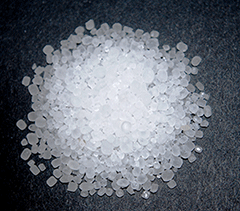
Ammonium sulfate

Specifications
| Item | Index | ||||
| Superior product | First class | Qualified product | |||
| Appearance | White crystals,no visible mechanical impurities | No visible mechanical impurities | No visible mechanical impurities | ||
| Nitrogen (N) content (dry basis) | ≥21.0 | ≥21.0 | ≥20.5 | ||
| Moisture (H20) | ≤0.2 | ≤0.3 | ≤1.0 | ||
| Free acid (H2S0, content | ≤0. 03 | ≤0.20 | ≤0.05 | ||
| Iron (Fe) content | ≤0.007 | — | — | — | |
| Arsenic (As) content | ≤0.00005 | — | — | — | |
| Heavy metal (calculated as Pb) content | ≤0.005 | — | — | — | |
| Water insoluble content | ≤0.01 | — | — | — | |
Packing & Storage
| Packing | It can be packaged in various items: 25 kg bags, 50 kg bags and in 1000 kg big bags. | |||||||
| Storage | The product is stored in a cool and ventilated warehouse to prevent moisture and rain. Keep away from fire and heat sources.It should be stored separately from acids and alkalis, and mixed storage and transportation should not be avoided. | |||||||
| Transportation | When handling, it should be lightly loaded and unloaded to prevent damage to the packaging and containers. Personal protection should be paid attention to during packing and handling operations. | |||||||
Free Quote
For samples, pricing, or more information, please call us at 0086 25 51192301 or mail to info@ascent-chem.com or fill out the following form.
We will respond to you as soon as possible.
Tel: 0086 25 51192301
E-mail: info@ascent-chem.com



General Information
Chemical & Physical Information
Safety Information
Synthetic Route
Chemical & Physical Information
| Common Names | Ammonium sulfate, ammonium sulphate | |||||||
| Structure |  H8N2O4S H8N2O4S | |||||||
| CAS No. | 7783-20-2 | Boiling Point (℃) | 330ºC at 760 mmHg | |||||
| Molecular Weight | 132.139 | Melting Point (℃) | 280ºC | |||||
| Appearance | White crystals,no visible mechanical impurities | Density | 1.76 | |||||
| HS Code | 3102210000 | Flash Point (ºC) | 26 °C | |||||
| Solubility | Soluble in water, insoluble in alcohol and acetone. | LogP | 0.75190 | |||||
Safety Information
| Safety Phrases | S26-S37/39 | ||
| RIDADR | UN 1170 3/PG 3 | ||
| WGK Germany | 1 | ||
| Hazard Codes | Xi:Irritant | ||
| RTECS | BS4500000 | ||
| SYMPTOMS | PREVENTION | FIRST AID | |
| Inhalation | Dry nose, inflammation of the upper respiratory tract, and heartburn may occur. | When emergency rescue or evacuation, it is recommended to wear self-contained breathing apparatus. | Leave the scene to a place with fresh air. Give oxygen when you have difficulty breathing. When breathing stops, perform artificial respiration immediately. Seek medical attention. |
| Skin | This product can cause skin damage, dry skin, thickened stratum corneum, chapped skin, desquamation | Wear overalls and rubber gloves | Rinse thoroughly with soapy water and clear water. Seek medical attention. |
| Eyes | Redness. Pain. | Wear chemical safety goggles | Open the eyelids and rinse with flowing water for 15 minutes. Seek medical attention. |
| Ingestion | Headache, dizziness, fatigue | Do not eat, drink, or smoke during work. Wash hands before eating. | Those who take it by mistake, drink an appropriate amount of warm water to induce vomiting.Seek medical attention |
Synthetic Route
| Dissolve ammonium sulfate in cold water to a relative density of 1.20. Add an appropriate amount of ammonia to adjust the pH value of the solution to 8~9, let stand, absorb the supernatant, add a small amount of activated carbon to the supernatant, heat, boil, and keep warm at 60℃. Then add ammonia to a ph value of 9 to 10. Let stand and cool to room temperature. Filter, evaporate the filtrate to precipitate crystals, and dry at 70℃ to obtain pure ammonium sulfate. |
Frequently Asked Questions
About Us
Ascent Petrochem Holdings Co., Limited is a company specializes in the processing and marketing industry chain of petrochem and coal chemical industry, by persistently pushing forward with high-tech and service innovation. We are committed to becoming China’s best diversified chemical company which focusing on technologies and services.
Contact Us
